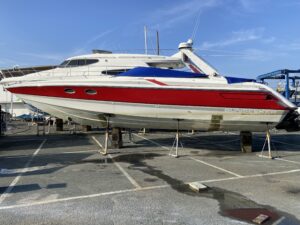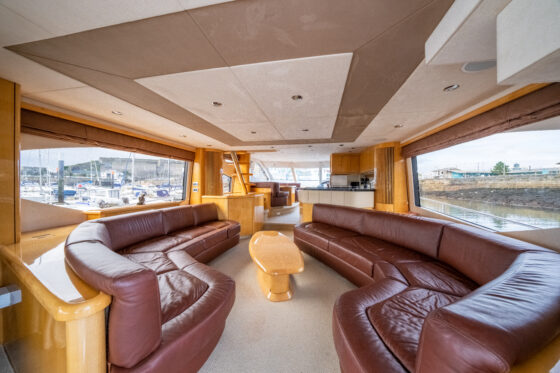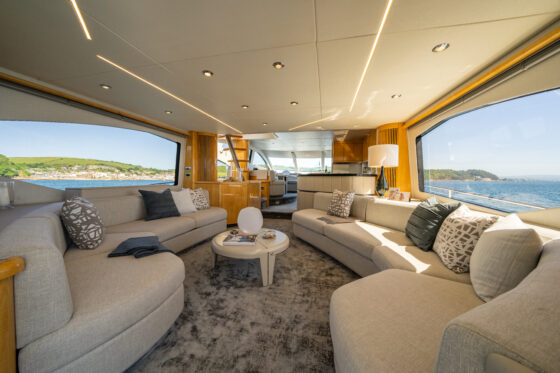
Industry spotlight: the rise of retrofitting

‘Retrofit’, ‘refurb’ and ‘recycle’ are all parts of the circular economy’s language and are key tenets of the environmental push, which is slowly changing the way consumers buy across all industries.
While buying ‘second-third-fourth hand’ has long been embraced by many boat owners (with well-made product lasting for decades), marine companies and owners are now looking to capitalise on upcycling – the art of taking an object that might be otherwise discarded and reusing it to create a product that is higher quality/value than the original. It’s different from a singular refit of one aspect – it’s about a holistic approach to making a product better, while making the customer journey as straightforward as possible.
This trend has started with motoryachts where Setag Yacht’s CEO Chris Gates spotted a market with huge potential soon after taking retirement and couldn’t resist returning to work.
Gates says his new business is “the biggest upcycler in the industry”. The company, formed in 2021, employing 14, and based in Plymouth offers complete refurbishments for Princess, Fairline and Sunseeker yachts (and more).
He says the superyacht refit market has been important and profitable for many years, and Setag is realising the opportunity for refits in the £100,000 to £10 million market, filling what he terms as “a huge gap in a traditionally fragmented repair market, to provide the one-stop-shop for owners to have all the work done.”

“It’s so simple in concept,” Gates adds. “That service level doesn’t exist elsewhere, the one-stop element. There are a lot of people out there servicing parts of the industry, but we offer a collection of very experienced people in one place. We’re offering a complete design-led service to the pre-owned market.”
Setag is making the most of a combination of economic drivers. Demand is at an all-time high across the world, international builders are out of entrepreneurial ownership and into corporate ownership and prices are going up dramatically. But these all sit on top of the fact that while cost is at the greatest it’s been, as Gates continually stresses, so is demand. And, further to this, powerhouse builders have considerably increased the average model size. “There’s a gap in under 60ft models being made,” says Gates, “but a fantastic stock of pre-owned boats ripe for refit.”
That’s where the upcycle comes into its own. “The boating industry is like high-end fashion – you have to excite the same customer continually,” says Gates. “By default, anything that is pre-owned dates quickly. They have classic lines – but the interior might not
be to taste.”
Gates adds: “£200k will get you a decent pre-owned but the inside may be very disappointing. Anybody spending that money should be very proud of what they get. They don’t want to spend time maintaining or making excuses for it.” After a refurbishment customers can have a practically new boat at a fraction of the cost.

Sunseeker 75 before Setag refit Sunseeker 75 after Setag refit
Sunseeker 75 after Setag refit
Gates says that 80 per cent of his business so far has come from long-term owners. The remainder are people who’ve bought yachts and immediately want them refreshed. There are lots of ‘feeder products’ to keep Setag busy, meaning as people buy new, more second-hand products become available. “There is plenty of room in the market for our services. New boat buyers feed the pool of pre-owned products.”
Chris Fowey, sales and marketing director for Fischer Panda UK, is also experiencing a surge in long-term owners looking to up-spec. The company is taking advantage of this growth opportunity, which he believes has arisen as the marine trade is still struggling with supply chain backlog. This has pushed new build slots off into the distant future meaning owners are spending their money on upgrading instead of buying new.
Fischer Panda has been active in refits since its inception but Fowey reports he’s seeing far more package deals, around generators and system solutions “to enhance and develop what owners have onboard” including air-conditioning and water makers.
“The backlog of build slots is creating opportunities in the retrofit market,” says Fowey.
“A boat owner has a perfectly good boat, but can add more luxury items and enhance specifications, ticking medium-and long-term boxes. The traditional boat owners, living a bit of a ‘rough’ lifestyle [without various home comforts onboard] are dwindling out of interactions I’m having with customers.
Modern-day boaters expect luxury onboard and all those items need powering. So their systems need to scale up as demand increases.”
Fowey is keen to actively support the promotion of retrofitting as a viable option for owners. “It isn’t complicated,” he says, “if owners partner with the right yard, one that understands their boat systems, it takes away a lot of concerns and red tape about retrofit projects.
“We can enhance and improve, and bring new boat standards to an existing boat. We need more companies coming onto the field and seizing these opportunities. There is no needless waste,
it’s recycling.”
Currently Fowey’s focus is in bringing in hybrid systems, although that’s where costs can jump considerably. Packages typically start around £10,000 and rise to £100,000 in project value. Both companies agree that the majority of projects they’re working on are owner-driven upcycles.
“The refurbs are owner-led but there is opportunity for companies to specialise in retrofit and sale,” says Fowey.
While the system specification Fischer Panda is offering doesn’t yet offer a direct return on investment he says “it does help enhance the value of the boat from a resale perspective. If new owners are coming with families and partners, they will want to make them comfortable.”
According to Gates: “Most boats are fetching what they are asking for. The few owners who have sold are making more margin on top of the refit costs (which are included).”
But whether that will transition into a ‘fix and flip’ market model, with entrepreneurs buying, renovating and then selling boats for profit, or the market will stay owner-driven, remains to be seen.
